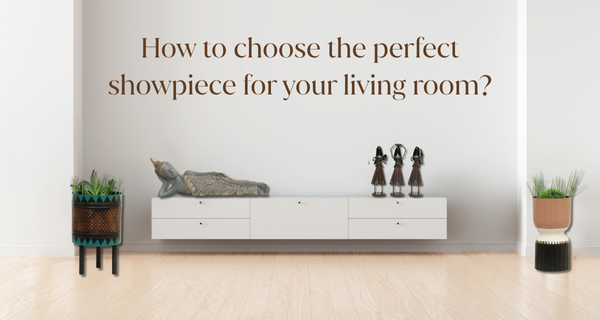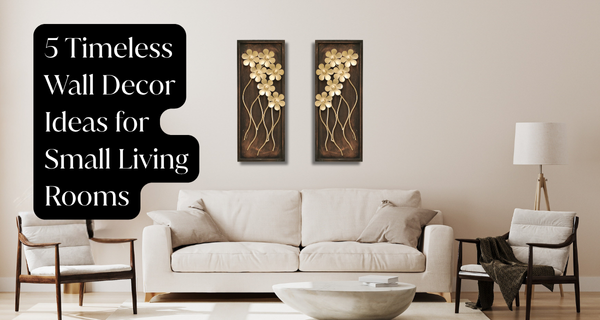The Ultimate Guide to Choosing the Right Wall Clock for Your Home
A wall clock is a piece of decor, an anchor in the room, and a reflection of your personal style. They are no longer just a functional time-keeper. zBe it a living room, dining room, bedroom, or home office, the right wall clock blends utility and aesthetic in perfect harmony. This guide will walk you through how to approach selecting a wall clock, from understanding the dual role of decor + utility, to choosing styles by room, to keeping abreast of the latest wall clock trends such as oversized styles, minimal metallic finishes, and vintage wooden designs. You’ll also discover how to select 4–5 standout options from VedasHome’s curated clock collection to suit your home.
What should you consider first: Decor or utility?
Before diving into styles and rooms, it’s critical to recognise the two main facets a wall clock must satisfy: functional utility and aesthetic appeal. On the utility side, it must be easily readable, appropriately sized, and placed where it serves its time-keeping purpose. On the decor side, it must complement your interior design, enhance rather than clash with your furniture, and act as a visual focal point or accent. Interior design authorities note that choosing a clock is “about finding a piece that feels both purposeful and personal”.
When you balance both utility and aesthetic, you get a clock that not only tells time but also elevates your space. A clock that looks like an after-thought may still function, but it fails to contribute to the look and feel of the room. Conversely, a beautiful clock that’s poorly placed or too small loses its function. The smartest choice is a clock that does both—and that is what this guide will help you achieve.
How to style a wall clock by room: living room, dining room, bedroom, office Living Room
In the living room which is often the most visible and sociable space, the wall clock should act as both a functional statement and decor anchor. Consider key placement: above the sofa, above a media console, or on a feature wall. A good rule of thumb: choose a clock whose diameter is roughly half the width of the sofa or at least one-third of the wall span. Oversized clocks work well here, as they draw the eye and tie together seating, decor, and layout. According to trend data, large decorative wall clocks continue to surge in popularity as focal pieces.
Also think about style match: For a warm, natural living room choose a wooden-frame vintage clock; for a modern minimal scheme go with brushed metal or metallic rim.
👉 Check out VedasHome’s living-room clock range- oversized vintage woods, modern metallics and more designed to match your decor.
Dining Room
The dining room offers an opportunity to integrate the wall clock with the table zone. Positioning is key: above or near the dining table, visible without dominating. In a dining room, the clock should not distract from the table setting but complement it. Consider subtle features like silent sweep movement (so you’re not hearing ticks while dining) and finishes that coordinate with dining lighting and table decor.
For dining rooms, minimal metallic styles or vintage wooden clocks provide elegance. One current trend emphasises statement wall clocks in dining areas that double as decor rather than just functional time-pieces.
👉 Explore VedasHome’s wall clocks for dining: silent mechanisms + stylish finishes for seamless table-room integration.
Bedroom
In a bedroom, the wall clock must be understated yet readable and should not dominate the restful aesthetic. Minimal silhouettes, muted colours or wood tones are ideal. Quiet or sweep-movement clocks reduce noise. Placement can be above the headboard, on a side wall, or adjacent to your dressing zone. Large clocks work beautifully when scaled appropriately; choose 20–28 inch diameters for standard walls.
👉 View VedasHome’s bedroom clocks — low noise, refined design, perfect for restful interiors.
Home Office
In a home office, the requirements lean more towards utility, but style shouldn’t be ignored- after all this is your workspace. A clock with a clean face, clear numerals, and a finish that complements built-in cabinetry or shelving works best. Minimal metallic or neutral wood finishes integrate well in modern home offices. Also consider additional features like silent quartz movement or built-in temperature/ humidity displays.
👉 Check out VedasHome’s functional & stylish office wall clocks- where time tracking and office decor walks hand in hand.
What are the trending styles in wall clocks? Oversized, minimal metallics, vintage wood
Oversized Wall Clocks
Large-scale wall clocks are trending strongly. These pieces often act more like design sculptures than time-tellers. These oversized clocks bring bold character to large walls or open-plan spaces. According to industry data, large decorative wall clocks are among the fastest-growing segments in home decor.
Style tips: Choose diameters of 24–36 inches for open areas; or above the sofa or console. Match with simple surrounding decor so the clock remains the focal point.
Minimal Metallics
For contemporary interiors, clocks in metallic finishes (brass, brushed steel, black metal) with clean faces and slim hands are in demand. These clocks offer subtle design enhancements without overwhelming the room. As per trend 2025, minimalist wall clocks with clean lines and neutral colours dominate modern clock designs.
Style tips: Pair with monochrome decor, ensure good contrast on the clock face (so readability is maintained), and keep surrounding wall decor light so the clock stands out.
Vintage Wooden Designs
Natural wood finishes, visible grain, rustic or antiqued styles are making a comeback. These clocks suit transitional, farmhouse, Swadesi-inspired or eclectic interiors. The right wall clock can act as an instant personality even in minimalist spaces.
Style tips: Choose mid-tone or dark woods, match the wood tone to other elements like furniture or flooring, and ensure the size is balanced so it doesn’t overpower smaller rooms.
Beyond style, functionality matters. Clocks with silent sweep movements, temperature/ humidity sensors, or even smart connectivity are rising. The market for multifunctional, silent operation clocks is increasing.
Style tip: For shared rooms or bedrooms, choose silent models; for smart homes, consider clocks with additional features but ensure they match the decor aesthetic.
How to choose the right clock: size, placement, readability, and style
Size & Proportion
Select a clock that matches the wall size and furniture below. A common guideline: the diameter of the clock should be at least one-third to one-half the width of the sofa or console it sits above. Too small and it looks lost; too large and it dominates. Designers often recommend 20–28 inch diameters in average rooms.
Placement
Key placement tips: hang clocks at eye level, centre at around 150–160 cm from the floor in living or dining rooms. Maintain at least 6–8 inches clearance above furniture so it visually floats rather than sits on top of it. In open-plan spaces clocks help define zones, place so the time is visible from seating or dining areas.
👉 Shop VedasHome clocks and follow our placement guide for perfect home integration.
Readability & Mechanism
Ensure the clock face is clear: good contrast between hands and background, appropriate numeral size and style. Consider quiet or silent mechanisms for bedrooms or shared rooms. Battery-operated quartz movements are low-maintenance, ideal for busy households. Avoid models that tick loudly or require frequent adjustment.
Style tip: A minimalist clock without numerals looks elegant but must offer clear time-reading at a glance.
Style & Finish
Match the clock finish with other metals or woods in the room- door handles, lighting fixtures, picture frames. For minimalist rooms, black, white or metal finishes work; for warm, natural interiors pick wooden frames. Choose a finish that sits well with your decor and avoid placing a clock on a heavily patterned wallpaper wall- it may get visually lost.
Function & Lifestyle Fit
If you have children, perhaps a silent mechanism and shatter-proof face make sense. If you entertain frequently, you might prefer a decorative oversized model. For home offices, additional features like temperature/ humidity or smart connectivity may be valuable.
Four to Five VedasHome Clock Products to Consider
Here are curated selections from VedasHome that match the styles described above:
- VedasHome “Vintage Walnut Oversized Wall Clock” – 30 inch diameter, vintage wooden frame, silent sweep movement.
- VedasHome “Minimalist Metal Rim Wall Clock” – 24 inch diameter, brushed steel rim, slim hands, black face.
- VedasHome “Swadesi Cane & Wood Wall Clock” – handcrafted cane inlay, mid-tone wood, 22 inch diameter.
- VedasHome “Matte Black Slim Wall Clock” – 20 inch diameter, minimalist design, no numerals, silent quartz movement.
- VedasHome “Brass Accent Gallery Wall Clock” – 26 inch diameter, brass finish, acts as central piece in a gallery wall arrangement.
Each of these options balances decor and utility, ensuring you get style without sacrificing function.
Common Mistakes to Avoid When Choosing a Wall Clock
- Choosing a clock that’s too small for the wall: it will look lost and fail to act as decor.
- Ignoring the finish and clash with other metals or woods in the room.
- Overlooking the mechanism: loud ticking or poor build quality can degrade the experience.
- Placing the clock in poor lighting or a cluttered wall area, making it hard to read or appreciate.
- Overemphasising trend at the expense of function. Don’t choose form over readability.
Frequently asked questions about wall clocks
Q1. What size wall clock should I choose for a living room?
Aim for a diameter at least one-third to one-half of the width of the sofa or related furniture. For example, a 72″ wide sofa works well with a clock 24–36 inches wide.
Q2. Should a wall clock match the other metals in the room?
Yes. Consistency in metal finishes (e.g., brass, black, steel) ensures the clock integrates seamlessly into your decor rather than standing out awkwardly.
Q3. Are silent wall clocks better for bedrooms and shared spaces?
Yes. Quiet sweep movements eliminate ticking noise, making them ideal for rest or study zones.
Q4. Is an oversized wall clock appropriate for a small room?
Only if proportion and placement are managed carefully. In tight spaces, oversized clocks risk overwhelming. Choose diameters on the lower end (20–24 inches) and keep surroundings uncluttered.
Q5. Can a wall clock act as wall decor instead of artwork?
Absolutely. A well‐chosen wall clock can replace artwork entirely, especially in rooms where function and style converge, such as home offices or dining rooms.
Choosing the right wall clock for your home is far more than picking something that tells time. It’s about finding a piece that fulfills utility and complements your decor, suits the room it will inhabit, and aligns with your lifestyle. By considering room-specific needs, current design trends (like oversized pieces, minimal metallics, vintage wood), and practical factors (size, placement, mechanism, finish), you will make a choice that enhances your home in both form and function.
👉 Ready to pick your perfect wall clock? Browse VedasHome’s curated collection today and find the piece that suits your space, style and budget.







